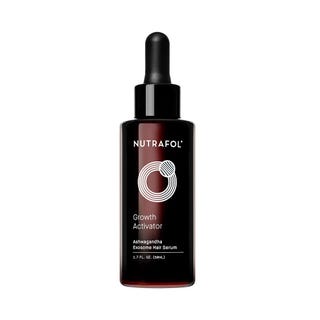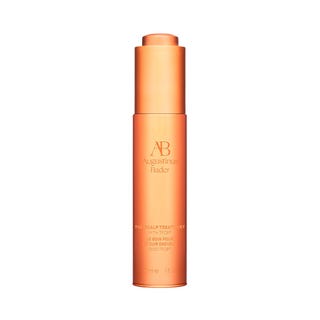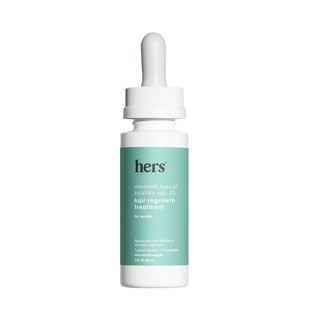Products You May Like
I’ve been a champion hair shedder for as long as I can remember. A small girl with a disproportionately large mop of hair, I recall repeatedly breaking my mom’s fine-tooth combs and meekly asking my dad if he could snake the drain. Again. And while stylists would often tell me how lucky I was to have such thick hair, I often felt anything but.
My shedding only seemed to intensify when I became an adult. It is now pretty much constant and incessant. Whenever I brush my hair or blow it dry with my Dyson, I’m greeted with a fistful of my own tresses. Countless roommates—and a few significant others—have been moved to comment on my abundance of strays, impossible to miss as they’re strewn across the bathroom floor.
There’s a reason some men, in particular, are startled by the volume of strand shedding. For one, women tend to have longer hair than men, and if you have longer strands, “it can feel like there’s more shedding happening because the hair ball looks bigger,” says Ronda S. Farah, MD, a dermatologist based in Minneapolis. New York City dermatologist Joyce Davis, MD, concurs: “Circling in the drain, one long strand of a woman’s hair is going to look like more than three short hairs from a guy’s scalp.” (It should be noted that there are a number of men who prefer that their SOs have long hair, so why judge them for shedding it? Hypocrisy at its finest.)
Yet I’m assured shedding is totally normal. And because my hair is so thick and grows quickly, the loss is routinely replaced, Davis tells me. “Young women with very thick hair have the metabolism to keep up with [the shedding],” she says. “They make hair, they lose hair; they get ahead of it.”
According to Davis, a typical amount of daily shedding is up to 100 hairs. “If you’re losing closer to 300 hairs a day, you should probably get it checked,” she cautions. Although that’s not to say you should count every last strand obsessively. “Be reasonable about it: See what’s in your brush; see what’s on your clothing; see what’s on your pillowcase; see what’s in the shower.”
If you do note a slight uptick in shedding, it’s typically not cause for alarm, says Megan Robinson, owner of Pearlita, a salon in New York City’s Nolita neighborhood. She believes increased shedding can be seasonal and often escalates in the summer. (There’s also evidence that hair may grow faster during warmer months, presumably because heat boosts blood flow to the scalp. So, in theory, new growth would keep pace with summer shedding.)
Another common cause of heightened shedding is an imbalanced diet, particularly a protein deficiency. “Hair is protein, but it’s the least important protein your body makes,” Davis says. So if you’re not eating enough protein, she explains, hair gets short shrift because your body prioritizes using protein reserves to maintain vital functions—not to nourish hair. She recommends taking a multivitamin with iron and eating at least two sources of amino-acid-rich protein daily—ideally from an animal source—to ensure that a nutritional deficit isn’t the root cause (pun intended) of increased shedding.
Other conditions that can intensify shedding: anemia, thyroid abnormalities, hormone swings (post-pregnancy or during menopause), certain medications, and overstyling that causes hair to break off or follicles to release strands en masse. (The latter is called traction alopecia and can be the result of wearing very tight styles, such as braids, for extended periods of time.) Illness, surgery, or a stressful life event can trigger a condition called telogen effluvium, in which up to 50 percent of the hair prematurely enters the shedding phase. Fallout from telogen effluvium typically occurs two to three months after the diagnosis or event in question, and the increased shedding may last for up to six months, says Cleveland dermatologist Shilpi Khetarpal, MD.
The good news? These conditions can all be addressed, and most are temporary. A doctor can prescribe treatment for an underlying condition, but there’s a lot you can do at home to boost new growth. Dermatologists frequently recommend minoxidil, such as Hers Minoxidil 2% Topical Solution, an over-the-counter drug applied topically to the scalp to increase follicle size and extend the growth phase. There are also a variety of drug-free scalp treatments that nourish the skin and boost blood flow to follicles, contributing to overall healthier hair. Try Nutrafol Growth Activator, Augustinus Bader The Scalp Treatment, or Virtue Flourish Density Booster.
Meanwhile, keep the shower (and the drain) cleaner with this easy trick from Robinson: “Brush your hair with a mixed-bristle brush before you shower,” she says, recommending the Crown Affair The Brush No. 001. “That way, all the hair that would otherwise shed into the drain comes out on the brush instead, keeping your shower (and your partner) much happier.”
And the next time you discover a tangle of strands on your pillow or bathroom floor and feel like freaking out? Remember what Farah said to me: “It’s normal to shed hair. Everybody is shedding hair all the time, and it can vary day today.” So take a deep breath, toss it in the trash, and carry on.
Healthy Hair Solutions
A nourishing scalp treatment—plus a brush to collect stray strands—can help you manage heavy shedding.
—Additional reporting by Emily Burns
This content is created and maintained by a third party, and imported onto this page to help users provide their email addresses. You may be able to find more information about this and similar content at piano.io





